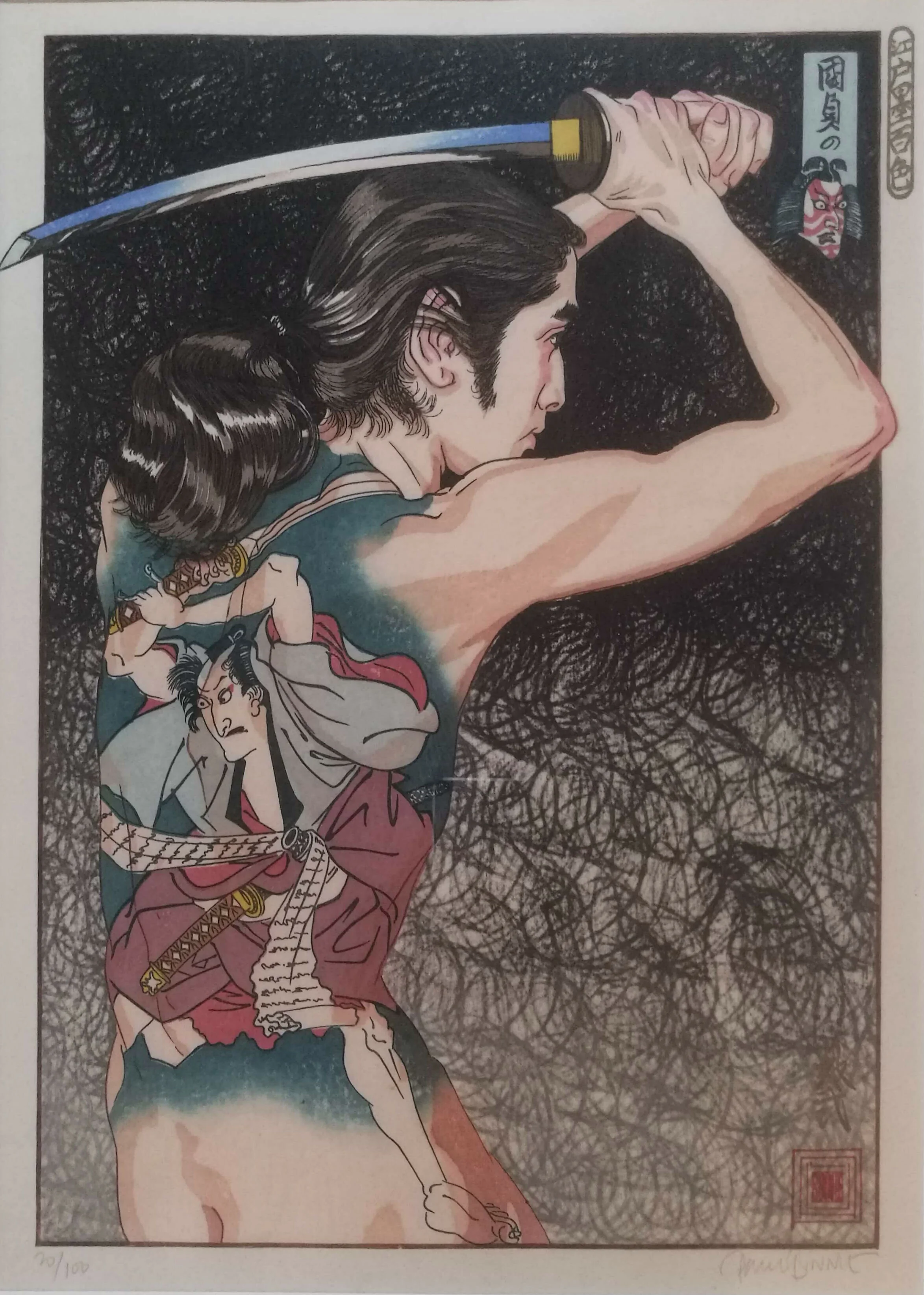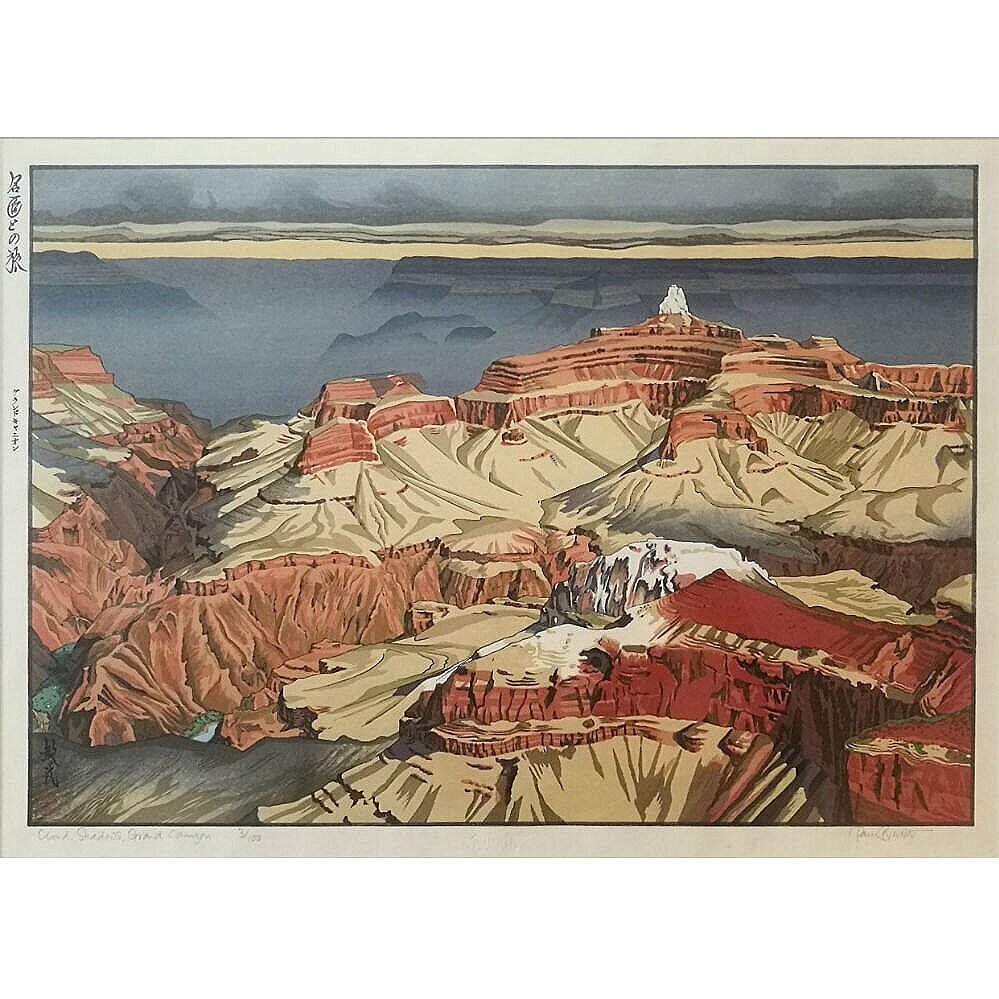



Paul Binnie - 国貞の團十郎 Kunisada's Danjūrō
Title: 国貞の團十郎 Kunisada's Danjūrō Ed. 70/100.
Series: 江戸墨百色 A Hundred Shades of Ink of Edo.
Binnie’s significant 江戸墨百色 A Hundred Shades of Ink of Edo series took his studies of the human body and passion for traditional ukiyo-e imagery, fusing them into a ten print series featuring nude models with elaborately tattooed imagery - each referencing famous themes of work from Japanese ukiyo-e woodblock print masters Utagawa Kuniyoshi (1798-1861), Tsukioka Yoshitoshi (1839-1892), Kitagawa Utamaro (1753-1806), Katsushika Hokusai (1760-1849), Utagawa Kunisada (1786-1865), Suzuki Harunobu (c.1724-1770), Keisai Eisen (1790-1848), Toshusai Sharaku (active c. 1794-1795), Torii Kiyonaga (1752-1815), & Utagawa Hiroshige (1791-1858). Each print of the series has a non-tattooed counterpart print design.
Artist: Paul Binnie (1967-Present).
Signed, Sealed & Dated:
Series title cartouche to upper right margin. Signed in pencil along with artist kanji signed in gold to lower right of image. Beneath, each print within Binnie’s A Hundred Shades of Ink of Edo series was adorned with a unique seal - in this case Binnie echoes the model’s striking pose & the print’s main design theme: the celebration & depiction of Ichikawa Danjuro VII (1791-1859) by Utagawa Kunisada (1786-1865) - cleverly constructing his “Binnie” seal to incorporate the Ichikawa “Mimasu” mon (family crest).
Print title to upper right of image (in the style of Kunisada’s signature) “Kunisada no + depicted face of the iconic kumadori (kabuki stage makeup) adorned face of Danjuro VII’s character Kamakura no Gongoro Kagemasa from his famous performance of “Shibaraku”. Published 2006.
Medium: Woodblock Print.
Paper Size: H: 42.20 cm x W: 31.50cm.
Condition: Shipped Framed (High quality grained grey/brown frame by specialists “The Framing Workshop”, Bath, UK, measuring: H: 71.00cm x W: 57.50cm). Print in extremely fine condition and fabulous example of Binnie’s baren sujizuri - circular baren/swirling printing technique evident to background. For 国貞の團十郎 Kunisada's Danjūrō, Binnie has embellished the tip of the katana with fabulous pale blue mica.
Notes: 国貞の團十郎 Kunisada's Danjūrō is Binnie’s fifth print of a ten design run series following 国芳の猫 Kuniyoshi’s Cats (2004), 芳年の化け物 Yoshitoshi’s Ghosts (2004), 歌麿の春画 Umetaro’s Erotica (2005), & 北斎の滝 Hokusai’s Waterfalls (2006). The counterpart non-tattooed print synonymous to every print of the series was published a year later in 2007, entitled “Sword”.
For 国貞の團十郎 Kunisada's Danjūrō, Binnie carved further blocks to integrate the figure of Ichikawa Danjuro VII (1791-1859) playing Sano Jirozaemon in his performance of 杜若艶色紫 Even the Irises Are Dyed with Edo Purple. The fabulous figure of Sano Jirozaemon tattooed onto the model is drawn from the right panel of Utagawa Kunisada’s (1786-1865) triptych titled “佐野次郎左衛門 市川団十郎”.
Paul Binnie - 国貞の團十郎 Kunisada's Danjūrō
Title: 国貞の團十郎 Kunisada's Danjūrō Ed. 70/100.
Series: 江戸墨百色 A Hundred Shades of Ink of Edo.
Binnie’s significant 江戸墨百色 A Hundred Shades of Ink of Edo series took his studies of the human body and passion for traditional ukiyo-e imagery, fusing them into a ten print series featuring nude models with elaborately tattooed imagery - each referencing famous themes of work from Japanese ukiyo-e woodblock print masters Utagawa Kuniyoshi (1798-1861), Tsukioka Yoshitoshi (1839-1892), Kitagawa Utamaro (1753-1806), Katsushika Hokusai (1760-1849), Utagawa Kunisada (1786-1865), Suzuki Harunobu (c.1724-1770), Keisai Eisen (1790-1848), Toshusai Sharaku (active c. 1794-1795), Torii Kiyonaga (1752-1815), & Utagawa Hiroshige (1791-1858). Each print of the series has a non-tattooed counterpart print design.
Artist: Paul Binnie (1967-Present).
Signed, Sealed & Dated:
Series title cartouche to upper right margin. Signed in pencil along with artist kanji signed in gold to lower right of image. Beneath, each print within Binnie’s A Hundred Shades of Ink of Edo series was adorned with a unique seal - in this case Binnie echoes the model’s striking pose & the print’s main design theme: the celebration & depiction of Ichikawa Danjuro VII (1791-1859) by Utagawa Kunisada (1786-1865) - cleverly constructing his “Binnie” seal to incorporate the Ichikawa “Mimasu” mon (family crest).
Print title to upper right of image (in the style of Kunisada’s signature) “Kunisada no + depicted face of the iconic kumadori (kabuki stage makeup) adorned face of Danjuro VII’s character Kamakura no Gongoro Kagemasa from his famous performance of “Shibaraku”. Published 2006.
Medium: Woodblock Print.
Paper Size: H: 42.20 cm x W: 31.50cm.
Condition: Shipped Framed (High quality grained grey/brown frame by specialists “The Framing Workshop”, Bath, UK, measuring: H: 71.00cm x W: 57.50cm). Print in extremely fine condition and fabulous example of Binnie’s baren sujizuri - circular baren/swirling printing technique evident to background. For 国貞の團十郎 Kunisada's Danjūrō, Binnie has embellished the tip of the katana with fabulous pale blue mica.
Notes: 国貞の團十郎 Kunisada's Danjūrō is Binnie’s fifth print of a ten design run series following 国芳の猫 Kuniyoshi’s Cats (2004), 芳年の化け物 Yoshitoshi’s Ghosts (2004), 歌麿の春画 Umetaro’s Erotica (2005), & 北斎の滝 Hokusai’s Waterfalls (2006). The counterpart non-tattooed print synonymous to every print of the series was published a year later in 2007, entitled “Sword”.
For 国貞の團十郎 Kunisada's Danjūrō, Binnie carved further blocks to integrate the figure of Ichikawa Danjuro VII (1791-1859) playing Sano Jirozaemon in his performance of 杜若艶色紫 Even the Irises Are Dyed with Edo Purple. The fabulous figure of Sano Jirozaemon tattooed onto the model is drawn from the right panel of Utagawa Kunisada’s (1786-1865) triptych titled “佐野次郎左衛門 市川団十郎”.
BIBLIOGRAPHY/ARTICLES:
Binnie Catalogue. [Online]. Binnie Catalogue. Available from: https://binniecatalogue.com. [Accessed: 24 November 2019].
Brown, K.H., Griffith, P., Akama Ryō & Ing, E.van den. (2007) Paul Binnie: A Dialogue with the Past: The First 100 Japanese Prints. Chicago, Art Media Resources.
Ichikawa Danjuro VII Biography: A life rich in tribulations (1791-1859). [Online]. NARITAYA - Ichikawa Danjuro Genealogy - Danjuro VII. Available from: http://www.naritaya.jp/english/compendium/genealogy_07.html [Accessed: 9 December 2019]. Original text/source: Hattori, Y. (2002) Ichikawa danjūrō daidai. Tokyo, Kodansha.
Leiter, S.L. (2002) A kabuki reader: history and performance. Armonk, NY, M.E. Sharpe.
Excellent Kabuki compendium: The story of 杜若艶色紫 Even the Irises Are Dyed with Edo Purple: DOTE NO OROKU. [Online]. Kabuki21 . Available from: https://www.kabuki21.com/dote_no_oroku.php [Accessed: 9 December 2019].





